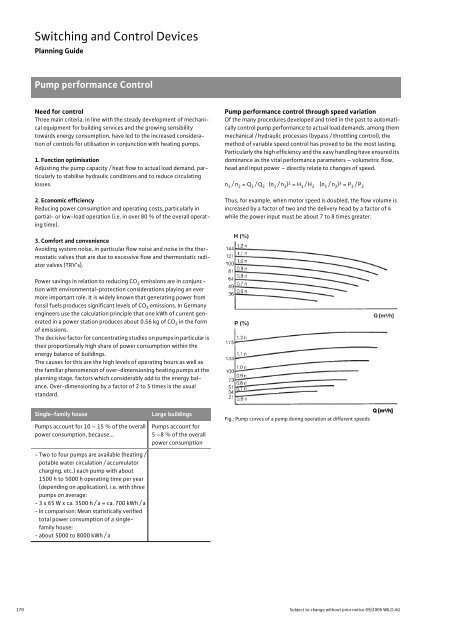Glanded Pumps - THERMO-ECO-ENGINEERING úvod
Glanded Pumps - THERMO-ECO-ENGINEERING úvod
Glanded Pumps - THERMO-ECO-ENGINEERING úvod
Create successful ePaper yourself
Turn your PDF publications into a flip-book with our unique Google optimized e-Paper software.
Switching and Control Devices<br />
Planning Guide<br />
Pump performance Control<br />
Need for control<br />
Three main criteria, in line with the steady development of mechanical<br />
equipment for building services and the growing sensibility<br />
towards energy consumption, have led to the increased consideration<br />
of controls for utilisation in conjunction with heating pumps.<br />
1. Function optimisation<br />
Adjusting the pump capacity / heat flow to actual load demand, particularly<br />
to stabilise hydraulic conditions and to reduce circulating<br />
losses.<br />
2. Economic efficiency<br />
Reducing power consumption and operating costs, particularly in<br />
partial- or low-load operation (i.e. in over 80 % of the overall operating<br />
time).<br />
3. Comfort and convenience<br />
Avoiding system noise, in particular flow noise and noise in the thermostatic<br />
valves that are due to excessive flow and thermostatic radiator<br />
valves (TRV’s).<br />
Power savings in relation to reducing CO 2 emissions are in conjunction<br />
with environmental-protection considerations playing an ever<br />
more important role. It is widely known that generating power from<br />
fossil fuels produces significant levels of CO 2 emissions. In Germany<br />
engineers use the calculation principle that one kWh of current generated<br />
in a power station produces about 0.56 kg of CO 2 in the form<br />
of emissions.<br />
The decisive factor for concentrating studies on pumps in particular is<br />
their proportionally high share of power consumption within the<br />
energy balance of buildings.<br />
The causes for this are the high levels of operating hours as well as<br />
the familiar phenomenon of over-dimensioning heating pumps at the<br />
planning stage, factors which considerably add to the energy balance.<br />
Over-dimensioning by a factor of 2 to 5 times is the usual<br />
standard.<br />
Single-family house Large buildings<br />
<strong>Pumps</strong> account for 10 – 15 % of the overall<br />
power consumption, because...<br />
- Two to four pumps are available (heating /<br />
potable water circulation / accumulator<br />
charging, etc.) each pump with about<br />
1500 h to 5000 h operating time per year<br />
(depending on application), i.e. with three<br />
pumps on average:<br />
- 3 x 65 W x ca. 3500 h / a = ca. 700 kWh / a<br />
- In comparison: Mean statistically verified<br />
total power consumption of a singlefamily<br />
house:<br />
- about 5000 to 8000 kWh / a<br />
<strong>Pumps</strong> account for<br />
5 –8 % of the overall<br />
power consumption<br />
Pump performance control through speed variation<br />
Of the many procedures developed and tried in the past to automatically<br />
control pump performance to actual load demands, among them<br />
mechanical / hydraulic processes (bypass / throttling control), the<br />
method of variable speed control has proved to be the most lasting.<br />
Particularly the high efficiency and the easy handling have ensured its<br />
dominance as the vital performance parameters – volumetric flow,<br />
head and input power – directly relate to changes of speed.<br />
n 1 /n 2 = Q 1 /Q 2 (n 1 /n 2) 2 = H 1 /H 2 (n 1 /n 2) 3 = P 1 /P 2<br />
Thus, for example, when motor speed is doubled, the flow volume is<br />
increased by a factor of two and the delivery head by a factor of 4<br />
while the power input must be about 7 to 8 times greater.<br />
Q [m 3/h]<br />
Q [m<br />
Fig.: Pump curves of a pump during operation at different speeds<br />
3/h] Q [m3/h] 170 Subject to change without prior notice 09/2006 WILO AG<br />
H (%)<br />
P (%)


